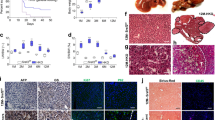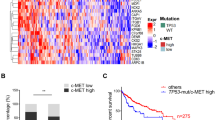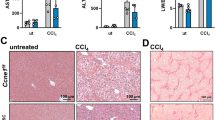Abstract
The molecular pathogenesis and the genetic aberrations that lead to the progression of hepatocellular carcinoma (HCC) are largely unknown. Here, we demonstrate that the thioredoxin interacting protein (Txnip) gene is a candidate tumor suppressor gene in vivo. We previously showed that the recombinant inbred congenic strain HcB-19 has a spontaneous mutation of the Txnip gene, and we now show that the strain has dramatically increased incidence of HCC, and that the HCC cosegregates with the Txnip mutation. Approximately 40% of the Txnip-deficient mice developed hepatic tumors with an increased prevalence in male mice. Visible tumors develop as early as 8 months of age. Histological analysis confirmed the morphology of HCC in the Txnip-deficient mice. Molecular markers of HCC, α-fetoprotein and p53, were increased in tumors of Txnip-deficient mice. The upregulation of p53 preceded tumor development; however, bromodeoxyuridine (BrdU) labeling of normal hepatic tissue of Txnip-deficient mice did not reveal increased cell proliferation. Finally, microarray analyses of tumor, non-tumor adjacent, and normal tissue of Txnip-deficient mice highlighted the genetic differences leading to the predisposition and onset of HCC. Our findings suggest that Txnip deficiency is sufficient to initiate HCC and suggest novel mechanisms in hepatocarcinogenesis.
This is a preview of subscription content, access via your institution
Access options
Subscribe to this journal
Receive 50 print issues and online access
$259.00 per year
only $5.18 per issue
Buy this article
- Purchase on Springer Link
- Instant access to full article PDF
Prices may be subject to local taxes which are calculated during checkout





Similar content being viewed by others
Accession codes
References
Bartkova J, Horejsi Z, Koed K, Kramer A, Tort F, Zieger K et al. (2005). Nature 434: 864–870.
Bechard D, Gentina T, Delehedde M, Scherpereel A, Lyon M, Aumercier M et al. (2001). J Biol Chem 276: 48341–48349.
Bodnar JS, Chatterjee A, Castellani LW, Ross DA, Ohmen J, Cavalcoli J et al. (2002). Nat Genet 30: 110–116.
Buendia MA . (2002). Med Pediatr Oncol 39: 530–535.
Capiati DA, Rossi AM, Picotto G, Benassati S, Boland RL . (2004). J Cell Biochem 93: 384–397.
Castellani LW, Weinreb A, Bodnar J, Goto AM, Doolittle M, Mehrabian M et al. (1998). Nat Genet 18: 374–377.
Chen F, Wang Q, Wang X, Studzinski GP . (2004). Cancer Res 64: 5425–5433.
Chen KS, DeLuca HF . (1994). Biochim Biophys Acta 1219: 26–32.
Chen X, Cheung ST, So S, Fan ST, Barry C, Higgins J et al. (2002). Mol Biol Cell 13: 1929–1939.
Demant P, Hart AA . (1986). Immunogenetics 24: 416–422.
Dragani TA, Manenti G, Sacchi MR, Colombo BM, Della Porta G . (1989). Mol Carcinog 2: 355–360.
Dudoit S, Fridlyand J . (2002). Genome Biol 3, RESEARCH0036.
Elchuri S, Oberley TD, Qi W, Eisenstein RS, Jackson Roberts L, Van Remmen H et al. (2005). Oncogene 24: 367–380.
Escrich E, Moral R, Garcia G, Costa I, Sanchez JA, Solanas M . (2004). Mol Carcinog 40: 73–78.
Faith DA, Isaacs WB, Morgan JD, Fedor HL, Hicks JL, Mangold LA et al. (2004). Prostate 61: 215–227.
Feitelson MA, Duan LX . (1997). Am J Pathol 150: 1141–1157.
Feng SL, Guo Y, Factor VM, Thorgeirsson SS, Bell DW, Testa JR et al. (2000). Am J Pathol 156: 1253–1261.
Furutani M, Arii S, Higashitsuji H, Mise M, Niwano M, Harada T et al. (1996). Hepatology 24: 1441–1445.
Goldberg SF, Miele ME, Hatta N, Takata M, Paquette-Straub C, Freedman LP et al. (2003). Cancer Res 63: 432–440.
Grondahl-Hansen J, Christensen IJ, Rosenquist C, Brunner N, Mouridsen HT, Dano K et al. (1993). Cancer Res 53: 2513–2521.
Han SH, Jeon JH, Ju HR, Jung U, Kim KY, Yoo HS et al. (2003). Oncogene 22: 4035–4046.
Heinzelmann-Schwarz VA, Gardiner-Garden M, Henshall SM, Scurry J, Scolyer RA, Davies MJ et al. (2004). Clin Cancer Res 10: 4427–4436.
Hsu HC, Tseng HJ, Lai PL, Lee PH, Peng SY . (1993). Cancer Res 53: 4691–4694.
Ikarashi M, Takahashi Y, Ishii Y, Nagata T, Asai S, Ishikawa K . (2002). Anticancer Res 22: 4045–4048.
Jeon JH, Lee KN, Hwang CY, Kwon KS, You KH, Choi I . (2005). Cancer Res 65: 4485–4489.
Jiang F, Bao J, Li P, Nicosia SV, Bai W . (2004). J Biol Chem 279: 53213–53221.
Jiao W, Miyazaki K, Kitajima Y . (2002). Br J Cancer 86: 98–101.
Kim CM, Koike K, Saito I, Miyamura T, Jay G . (1991). Nature 351: 317–320.
Koteish A, Yang S, Lin H, Huang J, Diehl AM . (2002). Alcohol Clin Exp Res 26: 1710–1718.
Lee KN, Kang HS, Jeon JH, Kim EM, Yoon SR, Song H et al. (2005). Immunity 22: 195–208.
Lee YI, Hwang JM, Im JH, Lee YI, Kim NS, Kim DG et al. (2004). J Biol Chem 279: 15460–15471.
Maronpot RR, Fox T, Malarkey DE, Goldsworthy TL . (1995). Toxicology 101: 125–156.
Minn AH, Hafele C, Shalev A . (2005). Endocrinology 146: 2397–2405.
Miyaguchi S, Watanabe T . (2000). Hepatogastroenterology 47: 468–472.
Pajukanta P, Bodnar JS, Sallinen R, Chu M, Airaksinen T, Xiao Q et al. (2001). Mamm Genome 12: 238–245.
Pourgholami MH, Akhter J, Lu Y, Morris DL . (2000). Cancer Lett 151: 97–102.
Powis G, Montfort WR . (2001). Annu Rev Pharmacol Toxicol 41: 261–295.
Saitoh T, Tanaka S, Koike T . (2001). J Neurochem 78: 1267–1276.
Scherpereel A, Gentina T, Grigoriu B, Senechal S, Janin A, Tsicopoulos A et al. (2003). Cancer Res 63: 6084–6089.
Sergeev IN . (2004). J Steroid Biochem Mol Biol 89–90: 419–425.
Sheth SS, Castellani LW, Chari S, Wagg C, Thipphavong CK, Bodnar JS et al. (2005). J Lipid Res 46: 123–134.
Shih DM, Xia YR, Wang XP, Miller E, Castellani LW, Subbanagounder G et al. (2000). J Biol Chem 275: 17527–17535.
Solmi R, De Sanctis P, Zucchini C, Ugolini G, Rosati G, Del Governatore M et al. (2004). Int J Oncol 25: 1049–1056.
Tackels-Horne D, Goodman MD, Williams AJ, Wilson DJ, Eskandari T, Vogt LM et al. (2001). Cancer 92: 395–405.
Takahashi Y, Nagata T, Ishii Y, Ikarashi M, Ishikawa K, Asai S . (2002). Oncol Rep 9: 75–79.
Trowbridge JM, Gallo RL . (2002). Glycobiology 12: 117R–125R.
Wei Y, Van Nhieu JT, Prigent S, Srivatanakul P, Tiollais P, Buendia MA . (2002). Hepatology 36: 692–701.
Yamada Y, Karasaki H, Matsushima K, Lee GH, Ogawa K . (1999). Lab Invest 79: 1059–1067.
Yang X, Young LH, Voigt JM . (1998). Breast Cancer Res Treat 48: 33–44.
Zhou L, Hayashi Y, Itoh T, Wang W, Rui J, Itoh H . (2000). Pathol Int 50: 392–397.
Acknowledgements
This study was supported by NIH Grant HL28481 (AJL) and the Johnson Comprehensive Cancer Center, UCLA.
Author information
Authors and Affiliations
Corresponding author
Additional information
Supplementary Information accompanies the paper on Oncogene website (http://www.nature.com/onc).
Supplementary information
Rights and permissions
About this article
Cite this article
Sheth, S., Bodnar, J., Ghazalpour, A. et al. Hepatocellular carcinoma in Txnip-deficient mice. Oncogene 25, 3528–3536 (2006). https://doi.org/10.1038/sj.onc.1209394
Received:
Revised:
Accepted:
Published:
Issue Date:
DOI: https://doi.org/10.1038/sj.onc.1209394
Keywords
This article is cited by
-
The role of TXNIP in cancer: a fine balance between redox, metabolic, and immunological tumor control
British Journal of Cancer (2023)
-
Comparison of the efficacy of the mouse hepatic and renal antioxidant systems against inflammation-induced oxidative stress
Cell Biochemistry and Biophysics (2023)
-
C-terminal truncated HBx initiates hepatocarcinogenesis by downregulating TXNIP and reprogramming glucose metabolism
Oncogene (2021)
-
Expression of TXNIP is associated with angiogenesis and postoperative relapse of conventional renal cell carcinoma
Scientific Reports (2021)
-
The role of thioredoxin system in cancer: strategy for cancer therapy
Cancer Chemotherapy and Pharmacology (2019)



